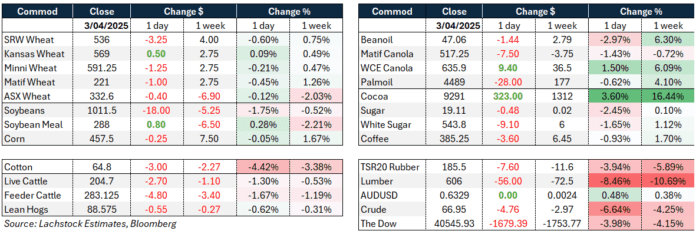In today’s global agricultural market, there are numerous factors influencing the trading environment. From extreme weather patterns to macroeconomic conditions, traders and analysts must navigate through a complex landscape to make informed decisions. Let’s delve into some key developments shaping the market dynamics.
Weather remains a significant driver of market sentiment, with notable fluctuations observed worldwide. For instance, the US is experiencing drastic temperature swings, with states like Oklahoma and Kansas bracing for sub-freezing temperatures following a week of unseasonably high temperatures. Dryness concerns in regions like China, Germany, and Russia are also on the radar, adding to the market’s uncertainty.
When it comes to market trends, the influence of macroeconomic factors, particularly currency movements and capital flows, seems to overshadow traditional production fundamentals. The recent volatility in agricultural markets, partly fueled by Donald Trump-inspired market noise, underscores the importance of monitoring broader economic indicators alongside supply and demand dynamics. Despite this backdrop, US futures have shown resilience, indicating a degree of stability amidst the turbulence.
In the Australian market, traders are facing challenges in building substantial positions due to the increasing divergence between the northern and southern regions. This divergence calls for a more defensive approach to trading strategies, reflecting the nuanced dynamics at play in the domestic market.
Turning our focus to offshore markets, the wheat sector has witnessed notable volatility, with different varieties like SRW, HRW, and HRS displaying varying price dynamics. Recent sales to Nigeria highlight the competitive pricing of HRW, while concerns over dryness in the EU and China add further complexity to the global wheat landscape. The short positioning in Matif, particularly in the May contract, has garnered attention, signaling potential market shifts in the near term.
In other grains and oilseeds, corn has shown resilience amid broader market weakness, with US corn maintaining its competitive edge in global markets. Soybean prices have been affected by oilshare corrections and tariff burdens on China, with Brazil’s strong export demand and Argentina’s slow harvest adding to the market dynamics. Political uncertainties and trade complexities continue to influence the oilseed complex, with potential policy support for biofuels offering a glimmer of hope amid the uncertainty.
On the macroeconomic front, Trump’s tariff policies have created ripples in financial markets, leading to a decline in the dollar and heightened volatility in equities and bond yields. Safe-haven flows have bolstered currencies like the yen and Swiss franc, highlighting investors’ risk-off sentiment. As tensions escalate on the global trade front, agricultural commodities may find themselves at the center of negotiations, with implications for market participants.
In the Australian context, recent developments in canola, wheat, and barley prices reflect the interconnected nature of global agricultural markets. Improved canola bids and evolving trade dynamics, including tariffs affecting key wheat importers, underscore the need for a proactive approach to market analysis and decision-making.
As market participants navigate through these dynamic landscapes, staying informed about key developments and leveraging insights from industry experts becomes crucial. By closely monitoring weather patterns, macroeconomic trends, and trade dynamics, traders can adapt their strategies to capitalize on emerging opportunities and mitigate risks in the ever-changing agricultural market environment.




